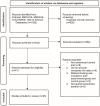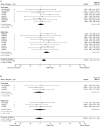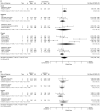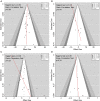Effectiveness and Success Factors of Bilateral Arm Training After Stroke: A Systematic Review and Meta-Analysis
- PMID: 35547621
- PMCID: PMC9082277
- DOI: 10.3389/fnagi.2022.875794
Effectiveness and Success Factors of Bilateral Arm Training After Stroke: A Systematic Review and Meta-Analysis
Abstract
Bilateral arm training (BAT) presents as a promising approach in upper extremity (UE) rehabilitation after a stroke as it may facilitate neuroplasticity. However, the effectiveness of BAT is inconclusive, and no systematic reviews and meta-analyses have investigated the impact of different factors on the outcomes of BAT. This systematic review and meta-analysis aimed to (1) compare the effects of bilateral arm training (BAT) with unilateral arm training (UAT) and conventional therapy (CT) on the upper limb (UL) motor impairments and functional performance post-stroke, and (2) investigate the different contributing factors that may influence the success of BAT. A comprehensive literature search was performed in five databases. Randomized control trials (RCTs) that met inclusion criteria were selected and assessed for methodological qualities. Data relating to outcome measures, characteristics of participants (stroke chronicity and severity), and features of intervention (type of BAT and dose) were extracted for meta-analysis. With 25 RCTs meeting the inclusion criteria, BAT demonstrated significantly greater improvements in motor impairments as measured by Fugl-Meyer Assessment of Upper Extremity (FMA-UE) than CT (MD = 3.94, p = < 0.001), but not in functional performance as measured by the pooled outcomes of Action Research Arm Test (ARAT), Box and Block Test (BBT), and the time component of Motor Function Test (WMFT-time) (SMD = 0.28, p = 0.313). The superior motor impairment effects of BAT were associated with recruiting mildly impaired individuals in the chronic phase of stroke (MD = 6.71, p < 0.001), and applying a higher dose of intervention (MD = 6.52, p < 0.001). Subgroup analysis showed that bilateral functional task training (BFTT) improves both motor impairments (MD = 7.84, p < 0.001) and functional performance (SMD = 1.02, p = 0.049). No significant differences were detected between BAT and UAT for motor impairment (MD = -0.90, p = 0.681) or functional performance (SMD = -0.09, p = 0.457). Thus, our meta-analysis indicates that BAT may be more beneficial than CT in addressing post-stroke UL motor impairment, particularly in the chronic phase with mild UL paresis. The success of BAT may be dose-dependent, and higher doses of intervention may be required. BFTT appears to be a valuable form of BAT that could be integrated into stroke rehabilitation programs. BAT and UAT are generally equivalent in improving UL motor impairments and functional performance.
Keywords: ICF model; bilateral arm training; meta-analysis; neuroplasticity; rehabilitation; stroke; upper extremity.
Copyright © 2022 Chen, Qiu, Bassile, Lee, Chen and Xu.
Conflict of interest statement
The authors declare that the research was conducted in the absence of any commercial or financial relationships that could be construed as a potential conflict of interest.
Figures







Similar articles
-
Bilateral versus unilateral upper limb training in (sub)acute stroke: A systematic and meta-analysis.S Afr J Physiother. 2024 Jan 23;80(1):1985. doi: 10.4102/sajp.v80i1.1985. eCollection 2024. S Afr J Physiother. 2024. PMID: 38322652 Free PMC article. Review.
-
Effect of task-based bilateral arm training on upper limb recovery after stroke: A systematic review and meta-analysis.J Stroke Cerebrovasc Dis. 2023 Jul;32(7):107131. doi: 10.1016/j.jstrokecerebrovasdis.2023.107131. Epub 2023 May 4. J Stroke Cerebrovasc Dis. 2023. PMID: 37148628
-
Comparison of bilateral and unilateral upper limb training in people with stroke: A systematic review and meta-analysis.PLoS One. 2019 May 23;14(5):e0216357. doi: 10.1371/journal.pone.0216357. eCollection 2019. PLoS One. 2019. PMID: 31120910 Free PMC article.
-
Bimanual Arm Trainer Versus Traditional Occupational Therapy Services in Upper Extremity Function.Am J Occup Ther. 2024 Nov 1;78(6):7806205130. doi: 10.5014/ajot.2024.050784. Am J Occup Ther. 2024. PMID: 39361896
-
The effects of bilateral arm training on motor control and functional performance in chronic stroke: a randomized controlled study.Neurorehabil Neural Repair. 2010 Jan;24(1):42-51. doi: 10.1177/1545968309345268. Epub 2009 Sep 3. Neurorehabil Neural Repair. 2010. PMID: 19729583 Clinical Trial.
Cited by
-
Effect of Training Combining Hand-Arm Bimanual Intensive Therapy Concept and Postural Control Elements on Individuals With Chronic Incomplete Cervical Spinal Cord Injury: A Report of Two Cases.Cureus. 2025 Feb 26;17(2):e79695. doi: 10.7759/cureus.79695. eCollection 2025 Feb. Cureus. 2025. PMID: 40161096 Free PMC article.
-
Bilateral versus unilateral upper limb training in (sub)acute stroke: A systematic and meta-analysis.S Afr J Physiother. 2024 Jan 23;80(1):1985. doi: 10.4102/sajp.v80i1.1985. eCollection 2024. S Afr J Physiother. 2024. PMID: 38322652 Free PMC article. Review.
-
Home-based upper limb stroke rehabilitation mechatronics: challenges and opportunities.Biomed Eng Online. 2023 Jul 9;22(1):67. doi: 10.1186/s12938-023-01133-8. Biomed Eng Online. 2023. PMID: 37424017 Free PMC article. Review.
-
Hand-Arm Bimanual Intensive Therapy Including Lower Extremities (HABIT-ILE) in adults with chronic stroke: protocol of a randomised controlled trial.BMJ Open. 2023 Apr 13;13(4):e070642. doi: 10.1136/bmjopen-2022-070642. BMJ Open. 2023. PMID: 37055214 Free PMC article.
-
Post-Stroke Rehabilitation: Neurophysiology Processes of Bilateral Movement Training and Interlimb Coupling-A Systematic Review.J Clin Med. 2025 May 27;14(11):3757. doi: 10.3390/jcm14113757. J Clin Med. 2025. PMID: 40507519 Free PMC article. Review.
References
-
- Bernhardt J., Hayward K. S., Kwakkel G., Ward N. S., Wolf S. L., Borschmann K., et al. . (2017). Agreed definitions and a shared vision for new standards in stroke recovery research: the stroke recovery and rehabilitation roundtable taskforce. Neurorehabil. Neural Repair. 31, 793–799. 10.1177/1545968317732668 - DOI - PubMed
Publication types
LinkOut - more resources
Full Text Sources
Miscellaneous

